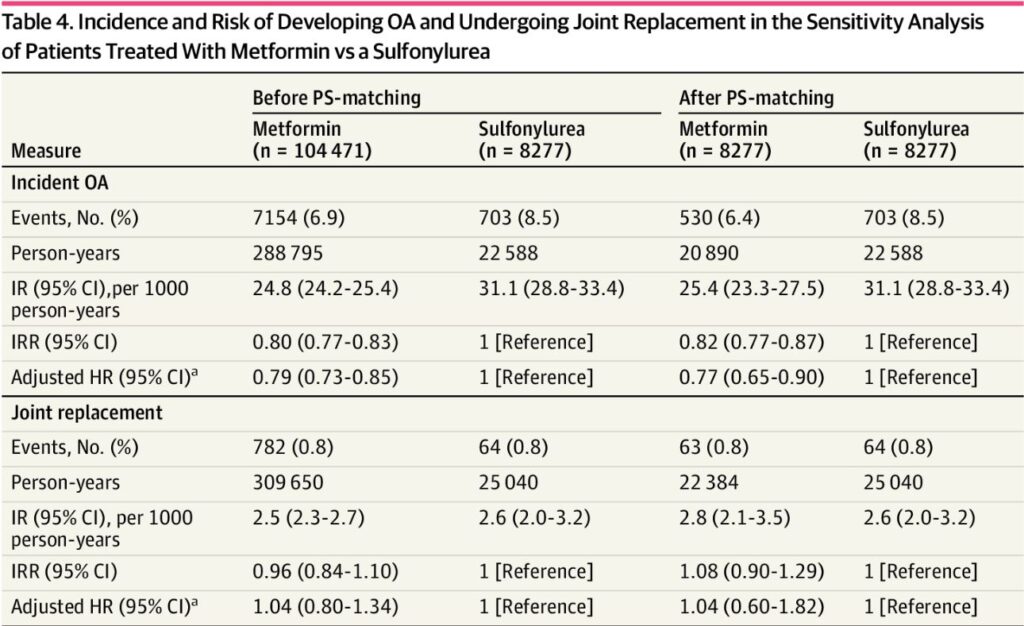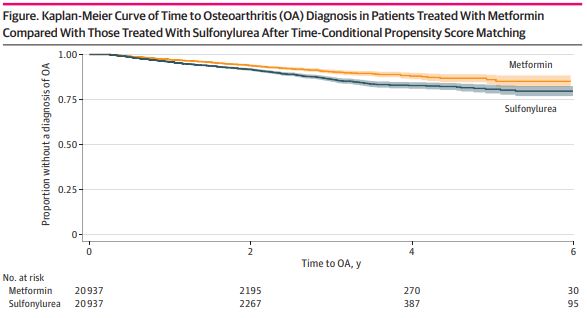
Click to Enlarge: Abbreviations: HR, hazard ratio; IR, incidence rate; IRR, incidence rate ratio; OA, osteoarthritis; PS, propensity score.
a. Adjusted for age, sex, race and ethnicity, Charlson comorbidity score, and treatment duration.
Source: JAMA Network Open
PALO ALTO, CA — Metformin is recommended as first-line therapy for Type 2 diabetes at the VA and elsewhere. Among the benefits, according to the VA PBM, is that the drug, which has been in use for decades, is low-cost and safe to initiate in most patients, even those with moderate renal dysfunction.
In recent years, research has hinted at many other advantages for the use of metformin, including protection against some types of cancers and cognitive decline. A new study suggests yet another benefit: lowering the incidence of osteoarthritis.
A study led by Stanford University and the Palo Alto, CA, Healthcare System suggested that the use of the first-line Type 2 diabetes drug was associated with a lower incidence of osteoarthritis. The authors went on to advise that future interventional studies with metformin for preventing OA should be considered.
The article in JAMA Network Open posited that metformin might be protective against developing OA but pointed out that supporting data has been lacking. In response, the study team sought to determine the risk of OA and joint replacement in individuals with Type 2 diabetes treated with metformin compared with a sulfonylurea.1
For the retrospective cohort study, the researchers used claims data from the Optum deidentified Clinformatics Data Mart Database between December 2003 and December 2019. Included were participants aged 40 years or older with at least 1 year of continuous enrollment and Type 2 diabetes. Excluded were those with Type 1 diabetes or a prior diagnosis of OA, inflammatory arthritis or joint replacement. Data were analyzed from April to December 2021.
The researchers were focused on incident OA and joint replacement in the two control groups, each of which included 20 937 individuals (mean [SD] age 62.0 [11.5] years; 24 379 [58.2%] males).
In the adjusted analysis, results indicated that the risk of developing OA was reduced by 24% for patients treated with metformin compared with a sulfonylurea (aHR, 0.76; 95% CI, 0.68-0.85; P <0 .001), although there was no significant difference for risk of joint replacement (aHR, 0.80; 95% CI, 0.50-1.27; P = 0.34).
In the sensitivity analysis, the researchers reported that the risk of developing OA remained lower in those treated with metformin compared with a sulfonylurea (aHR, 0.77; 95% CI, 0.65-0.90; P <0 .001), while the risk of joint replacement remained not statistically significant (aHR, 1.04; 95% CI, 0.60-1.82; P = 0.89).
Significant Reduction
“In this cohort study of individuals with diabetes, metformin treatment was associated with a significant reduction in the risk of developing OA compared with sulfonylurea treatment,” the authors concluded. “These results further support preclinical and observational data that suggest metformin may have a protective association against the development of OA; future interventional studies with metformin for the treatment or prevention of OA should be considered.”
Background information in the study pointed out that metformin is a biguanide derivative that is used as first-line treatment of Type 2 diabetes by inhibiting hepatic gluconeogenesis and increasing muscle insulin sensitivity. “Metformin is generally considered safe in most patient populations and is available at a low cost,” the researchers added. “ In addition to its primary role in the treatment of diabetes, metformin has been purported to have anti-inflammatory, anti-aging, anticancer, pro–weight loss, and immunomodulatory effects.”
They noted that animal studies have suggested that metformin could be useful for the treatment or prevention of OA, while observational studies in humans “have also largely supported the use of metformin associated with preventing the development of OA or the need for joint replacement.” Those studies mostly focused on the progression of preexisting OA, however, and had other confounders.
“In our large, nationwide cohort study of individuals with diabetes, metformin treatment was associated with a significant reduction in the risk of developing OA compared with sulfonylurea treatment,” the researchers wrote. “Results from this study must be interpreted with caution due to the lack of data on body mass index, and the possibility that weight loss induced by metformin may have accounted for some of the benefit seen. Despite this limitation, this study further supports the preclinical and observational data that show metformin may have a protective association against the development of OA. Future interventional studies with metformin for the treatment or prevention of OA should be considered.”
- Baker MC, Sheth K, Liu Y, Lu D, Lu R, Robinson WH. Development of Osteoarthritis in Adults With Type 2 Diabetes Treated With Metformin vs a Sulfonylurea. JAMA Netw Open. 2023;6(3):e233646. doi:10.1001/jamanetworkopen.2023.3646

